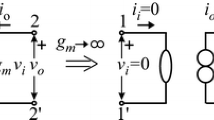Abstract
Recently Fixator-Norator Pairs (FNP) have been shown to be very powerful tools in designing analog circuits for multiple specs. These specs are separated into different areas of the design, and for each area a specific design methodology is introduced in this chapter. The areas mainly consist of designing for circuit biasing, gains, input and output impedances, active loads and current mirrors in ICs, and frequency responses and bandwidth for amplifiers. Very similar to a nullor, it is shown that the role of the fixator in an FNP is to provide a fixed and stable response to a circuit variable as specified by the design criteria. The norator, on the other hand, acts as a place holder for one or more circuit components that are needed to provide the requirements in the circuit to respond to spec, being held constant by the fixator. In designing for frequency and bandwidth, specifically, the mission is harder because of the complexity of the situation. It is shown that a model circuit helps in this case to provide the frequency response needed for the design. Since a model circuit is only for simulation purposes, it can be constructed from ideal components such as controlled sources, and it can be even built quite modular. As shown, the FNP methodology works for both linear and nonlinear circuits. However, for nonlinear circuits we need to keep the biasing situation unchanged during the AC design process. The circuit biasing may change when feedbacks are added to the original amplifier circuit, if not protected. In case needed, coupling capacitors are added to protect the circuit biasing. There are sections in the chapter, where each covers a separate feature and application of FNP in analog circuit design. Examples have also been worked out in rather details to show the role and significance of FNP in each application.
Access this chapter
Tax calculation will be finalised at checkout
Purchases are for personal use only
Similar content being viewed by others
Notes
- 1.
Active loads and current mirrors are similar in construction, and are used interchangeably. Here we only refer to them as active loads.
- 2.
T(s) can be of any of the four types of transfer functions: voltage to voltage, voltage to current, current to current, and current to voltage, and only the first type is selected for study here.
References
Hashemian R (2012) Application of fixator-norator Pairs in designing active loads and current mirrors in analog integrated circuits. IEEE Trans Very Large Scale Int (VLSI) Syst 20(12):2220–2231
Hashemian R (2016) Application of nullors in designing analog circuits for bandwidth. In: Proceedings of the IEEE International Conference on Electro/Information Technology, EIT2016, Grand Forks, ND, 19–21 May 2016
Hashemian R (2014) Fixator-norator pairs versus direct analytical tools in performing analog circuit designs. IEEE Trans Circuits Syst II Exp Briefs 61(8):569–573
Sedra AS, Smith KC (2014) Microelectronic circuits, 7th edn. Oxford University Press, New York
Baker RJ (2008) CMOS, circuit design, layout, and simulation, 2nd edn. IEEE Press, Wiley Interscience, pp 613–823
Verhoeven CJ, van Staveren A, Monna GLE, Kouwenhoven MHL, Yildiz E (2003) Structured electronic design: negative-feedback amplifiers. Kluwer Academic Publishers
Pillage TL, Rohrer RA, Visweswariah C (1995) Electronic circuit and system simulation methods. McGraw-Hill
Sánchez-López C, Ruiz_Pastor A, Ochoa-Montiel R, Carrasco-Aguilar MA (2013) Symbolic nodal analysis of analog circuits with modern multiport functional blocks. Radio Eng 22(2):518–525
Tlelo-Cuautle E, Sánchez-López C, Martınez-Romero E, Tan Sheldon X-D (2010) Symbolic analysis of analog circuits containing voltage mirrors and current mirrors. Analog Integr Circ Sig Process 65:89–95. https://doi.org/10.1007/s10470-010-9455-y
Fakhfakh M, Tlelo-Cuautle E, Fernández FV (2012) Design of analog circuits through symbolic analysis. https://books.google.com/books?isbn=1608050955, Computers 2012
Hashemian R (2017) Nullors in amplifier design for bandwidth using multiple feedbacks. In: 2017 IEEE 30th Canadian conference on electrical and computer engineering (CCECE), Windsor, CA, 30 April– 3 May, 2017
Author information
Authors and Affiliations
Corresponding author
Editor information
Editors and Affiliations
Rights and permissions
Copyright information
© 2018 Springer International Publishing AG, part of Springer Nature
About this chapter
Cite this chapter
Hashemian, R. (2018). Application of Fixator-Norator Pairs in Analog Circuit Design. In: Fakhfakh, M., Pierzchala, M. (eds) Pathological Elements in Analog Circuit Design. Lecture Notes in Electrical Engineering, vol 479. Springer, Cham. https://doi.org/10.1007/978-3-319-75157-3_10
Download citation
DOI: https://doi.org/10.1007/978-3-319-75157-3_10
Published:
Publisher Name: Springer, Cham
Print ISBN: 978-3-319-75156-6
Online ISBN: 978-3-319-75157-3
eBook Packages: EngineeringEngineering (R0)




